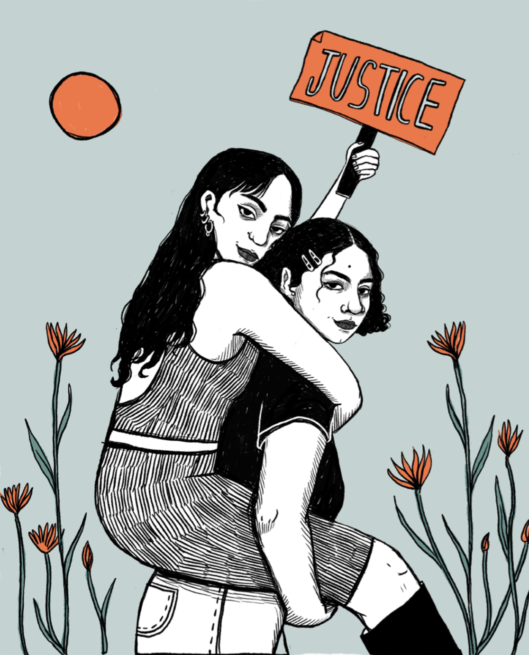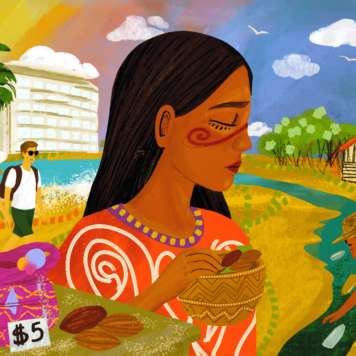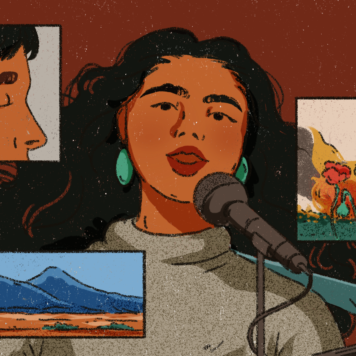Solidarity in the Latin American struggle for social justice has long been cadenced by music. In the 1970s and 80s, Latin America was moving to the beat of a radical rhythm, with over two decades of interconnected struggle against dictatorships, neoliberalism, and US imperialism across Latin America.
This shared soundtrack of resistance was a folk genre that came to be known as La Nueva Canción – the New Song – characterised by powerful lyrics, ladened voices, and the strum of a guitar. The possibility of a socialist future was on the horizon, and all of us committed to liberation have so much to learn from how music was used as a vehicle for mobilisation.
South America and the New Song
The 1990s are considered the high-water mark of neoliberalism in Latin America – with the groundwork for this having been laid decades prior. Against the backdrop of the Cold War, and the challenge to the world order posed by a newly liberated Cuba, during the 70s and 80s the US treated Latin America as a political football. The CIA’s ‘Operation Condor’ levelled an onslaught of political repression and propped up authoritarian regimes, which acted in the interest of the US, across the region. During this time, Latin America became a region defined by the chasm between rich and poor, and the harsh realities of injustice sowed the seeds for a revolutionary regional response.
One of the most prominent voices of La Nueva Canción in Chile was Violeta Parra, whose poetic, philosophical lyrics earned her the title of ‘mother of the genre’. Parra’s most famous song is ‘Gracias a la Vida’ (Thanks to Life), which despite a palpable sadness is an anthem of gratitude for the mundane, the everyday – the lyrics to which are pride of place on my bedroom wall. But her more pointedly political songs include La Carta (The Letter) where the balladeer sings, “the hungry ask for bread, the militias give them bullets.” Others include Arauco Tiene Una Pena (Arauco Has A Sorrow) where her lyrics speak to the people of Arauco, a region in Chile which was a core site of Indigenous resistance against Spanish colonial forces, and wills members of the Mapuche community – present-day Chile’s biggest Indigenous group – to ‘rise!’ and stand up against centuries of injustice against Indigenous populations in Chile.
Quilapayún, the group name meaning ‘three bearded men’ in Mapudungun, the Mapuche language, were also giants of the New Song genre. In the 40s, Colombian leftist Jorge Eliécer Gaitán first said the words that became the chant we’ve all heard on marches, “El pueblo unido jamás será vencido” (The people united will never be defeated). In 1974, in the wake of the military coup that installed the Pinochet dictatorship, Quilapayún put music to this renowned refrain, popularising it as a Chilean anthem, and a song that could bring hope to the oppressed all across the world.
It would be a disservice to speak about La Nueva Canción in Chile without highlighting the country’s bard, Victor Jara, who wrote his own version of socialist anthem Venceremos (We Will Win). Under the dictatorship, Jara was considered a threat due to his membership of the Communist Party and unwavering commitment to using music as a vehicle towards a socialist future. For this, he was assassinated in 1973. It was only in 2023 – four decades later – that Jara’s alleged killer was extradited, bringing some fresh hope for long overdue justice.
Elsewhere in the region, rhapsodist Alí Primera, popularly known as the ‘People’s Singer of Venezuela’, sang staunch anti-capitalist lyrics that spoke truth to power in exposing US imperialism; exploitative oil companies; and the role both played in producing poverty in the country. In his song Ruperto, for example, he sings:
“Ruperto came to Caracas, capitalism helped him. It helped him build his ranch […] with empty Mobil Esso cans. And he used a Ford Company poster as a roof: It’s easy to have a Mustang”.
With its cutting irony, this story is the polar opposite of a fairytale. Just as fairytales will us to believe in fictional happy endings, through this tale Primera forces us to examine the reality: the lie of the American dream, and the hypocrisy of transnational corporations who profited from Venezuelan land whilst, in reality, people were navigating destitution. It’s been documented that Primera received death threats for his staunch opposition to the right-wing regime in power at the time.
Known by a slightly different name – El Nuevo Cancionero (The New Songbook) – in Argentina, the genre was accompanied by a manifesto written in 1962, explaining that its music expressed the dreams, joy, struggles, and hope of the people. Co-developed by artists including Mercedes Sosa, Oscar Matus, Tito Francia and Eduardo Aragón, this manifesto served to capture the conscience, imagination and political vision of the Argentine public. Here, too, state repression marked the musical movement, including Sosa’s arrest during a performance in October 1978.
On the other side of La Plata River, Uruguayan singer-songwriter Alfredo Zitarrosa and Communist Party member who, in his song Adagio a mi país (Adage to my country) spoke of the ‘poverty and bitterness’ of his people, was exiled for his opposition to the dictatorship. These artists not only bore the weight of protesting the dictatorships their countries faced, but revolting against acquiescence to the then-growing empire of the United States – and the gravity of their collective power was met with equally heavy force. In the words of his comrade, fellow Uruguayan New Song musician, Daniel Viglietti: “insistence on Latin American culture, in a moment when the North American colossus is trying to devour one’s nation, is an act of resistance.”
Central America’s musical movement
Extending beyond the geographical boundaries of South America, the genre’s popularity was considerable in Central America, too. In Nicaragua, for example, there were close ties between this music and the Sandinista National Liberation Front, the revolutionary political party that opposed the Somoza dictatorship, and built grassroots power among the peasant-farmer class.
Nicaragua’s Carlos Mejía Godoy and Luis Enrique Mejía Godoy became cultural mobilisers of the revolution, with countless songs which became its soundtrack. These include Carlos’ composition of the Nicaraguan Peasants’ Mass which drew connection between faith, workers’ rights, and liberation, and Luis’ lyrics of Yo soy de un pueblo sencillo (I am from a simple people) which ends unequivocally: “I am from a simple people, friends who sow and defend the revolution.” They were making this music against a backdrop of political repression, which included censorship, torture, and even the assassination of Pedro Joaquín Chamorro Cardenal, who edited the opposition newspaper.
Then-newly liberated Cuba was a beacon of hope, and much of the region was following its lead in its anti-yanquismo (anti-US feeling) – rejecting capitalism and imperialism. The region was on the precipice of revolution. But, the other common thread that these movements shared was the undercurrent of repression that each of the musicians above, and many others active in the genre, faced. Dictators knew the power of culture, of music, and that’s why musicians speaking truth to power were actively intimidated, or otherwise silenced: killing musicians can help kill movements.
Solidarity beyond borders
One of the defining moments of this genre’s peak came well into La Nueva Canción’s popularisation. In 1983 a Concert For Peace took place in Managua, Nicaragua. Musicians from Cuba, Mexico, Brazil, Uruguay, Venezuela, Bolivia and Argentina came together to resist US-funded military oppression in Central America. This concert was a crystallising moment for the movement, symbolic of Latin American revolt against regimes propped up by the US: sending a clear message that they would build up the grassroots power needed to reclaim their respective political systems. This concert, and its public display of regional solidarity, was so desperately needed at the time because of the state repression that those daring to critique dictatorships faced, and was a bold move, particularly against the backdrop of the Cold War.
Even though the genre was so engulfed by, and responsive to, these tensions across the Americas, this musical movement wasn’t only focused on its own backyard. Academics Karmy and Schmiedecke explore how La Nueva Canción in Latin America “flew the flag of anti-imperialism and [demonstrated] their support for revolutionary efforts erupting across different parts of the globe” particularly through music which supported comrades in Vietnam facing US military aggression at the time. This movement sought to disrupt the global political order, and to build connection and solidarity through a common language – music.
It’s hard to do justice to decades of musical movement building, but even this whistle-stop tour of Latin America’s artistic history goes some way to illustrate why the region is still undeniably shaped by the revolutionary power that the New Song movement helped to sustain. Though, the region’s story is not a simple one. In some places, the trajectory set by the New Song is alive and well, but elsewhere a less hopeful melody is playing. I have lived in Boric’s Chile, fuelled by radical reimagination of the country’s future at the grassroots, and elected with the promise of real action of the climate emergency, and a new constitution that would foreground indigenous rights. But I have also lived in what, soon after I left, became Milei’s Argentina, whose election underscored the rise of neo-fascism in the country, and unleashed its climate-denying, public budget-slashing, anti-immigrant administration.
Whether helping to drive broader revolutionary efforts, or fighting a politically tough tide, we still see the reverberations of the New Song’s impact to this day, with politically conscious cultural mobilisation visible across the region.
The legacy of the New Song
The legends of the Nueva Canción genre have been able to pass the mic to a new generation of artists who are taking up the mantle of protest music in Latin America. While his genre and style might be different, Chilean rapper Portavoz has the same political intentions as his Nueva Canción predecessors. His debut album, Escribo Rap Con R De Revolucion (I Write Rap with R for Revolution), incisively addressed social injustice in the country, and its star track El Otro Chile (The Other Chile) even nodded to his compatriots in struggle, spitting “I come from the Chile of Victor Jara and Violeta Parra”. The song differentiates between the middle class image of Chile that is exported, and the working class Chile that he knows. “The Chile of street vendors, students in debt, workers and the unemployed frustrated by outsourcing, miners, the poor, and exploited workers.” An important distinction in the country known to be the cradle of neoliberalism.
Across the region, artistic efforts to resist injustice and embolden radical movements don’t stop at music. From the ongoing artistry of La Comuna as a mode of resistance for the queer community in Mexico City; to the feminist performance, Un Violador En Tu Camino (A Rapist In Your Path) which shaped cultural resistance during the Chilean social uprising of 2019, culture has long been – and continues to be – the bedrock of Latin American revolution.

Join our mailing list
Sign up for shado's picks of the week! Dropping in your inbox every Friday, we share news from inside shado + out, plus job listings, event recommendations and actions ✊
Sign up for shado's picks of the week! Dropping in your inbox every Friday, we share news from inside shado + out, plus job listings, event recommendations and actions ✊
What can you do?
-
- Listen to this playlist of La Nueva Canción Chilena
- Listen to this episode of the Alt.Latino podcast called Speaking truth to power through music
- Listen to this Musicians Stand for Justice – Visualizing Palestine playlist
- Listen to the I Write Rap with R for Revolution album by Chilean protest rapper Portavoz
- Read Whole World in an Uproar: Music, Rebellion and Repression – 1955-1972 by Aaron J Leonard
- Read about protest music in India
- If you’re based in the UK, go to the Beyond the Bassline exhibition at the British Library, mapping Black music in Britain including how it intertwines with anti-racism
- If you’re a musician, consider how your music can be part of revolution!





